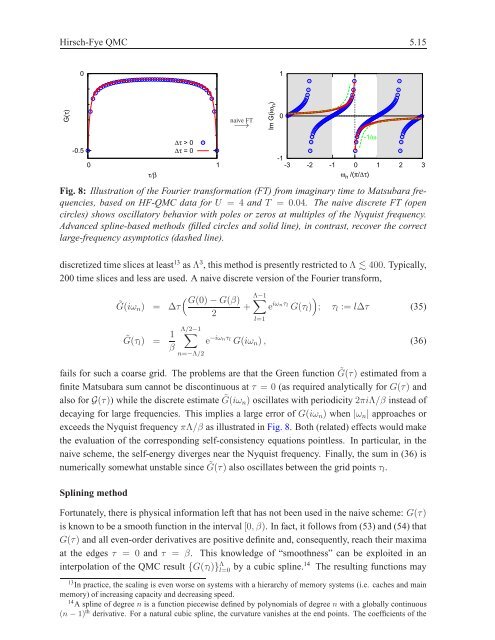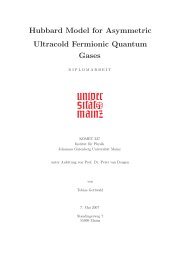5 Hirsch-Fye quantum Monte Carlo method for ... - komet 337
5 Hirsch-Fye quantum Monte Carlo method for ... - komet 337
5 Hirsch-Fye quantum Monte Carlo method for ... - komet 337
Create successful ePaper yourself
Turn your PDF publications into a flip-book with our unique Google optimized e-Paper software.
<strong>Hirsch</strong>-<strong>Fye</strong> QMC 5.15<br />
G(τ)<br />
0<br />
-0.5<br />
0 1<br />
τ/β<br />
∆τ > 0<br />
∆τ = 0<br />
naive FT<br />
−→<br />
Im G(iω n )<br />
1<br />
0<br />
-1/ω<br />
-1<br />
-3 -2 -1 0<br />
ωn /(π/∆τ)<br />
1 2 3<br />
Fig. 8: Illustration of the Fourier trans<strong>for</strong>mation (FT) from imaginary time to Matsubara frequencies,<br />
based on HF-QMC data <strong>for</strong> U = 4 and T = 0.04. The naive discrete FT (open<br />
circles) shows oscillatory behavior with poles or zeros at multiples of the Nyquist frequency.<br />
Advanced spline-based <strong>method</strong>s (filled circles and solid line), in contrast, recover the correct<br />
large-frequency asymptotics (dashed line).<br />
discretized time slices at least 13 asΛ 3 , this <strong>method</strong> is presently restricted toΛ � 400. Typically,<br />
200 time slices and less are used. A naive discrete version of the Fourier trans<strong>for</strong>m,<br />
�<br />
˜G(iωn)<br />
G(0)−G(β) �Λ−1<br />
= ∆τ + e<br />
2<br />
iωnτl<br />
�<br />
G(τl) ; τl := l∆τ (35)<br />
˜G(τl) = 1<br />
β<br />
Λ/2−1 �<br />
n=−Λ/2<br />
l=1<br />
e −iωnτl G(iωn), (36)<br />
fails <strong>for</strong> such a coarse grid. The problems are that the Green function ˜ G(τ) estimated from a<br />
finite Matsubara sum cannot be discontinuous at τ = 0 (as required analytically <strong>for</strong> G(τ) and<br />
also <strong>for</strong> G(τ)) while the discrete estimate ˜ G(iωn) oscillates with periodicity2πiΛ/β instead of<br />
decaying <strong>for</strong> large frequencies. This implies a large error of G(iωn) when |ωn| approaches or<br />
exceeds the Nyquist frequencyπΛ/β as illustrated in Fig. 8. Both (related) effects would make<br />
the evaluation of the corresponding self-consistency equations pointless. In particular, in the<br />
naive scheme, the self-energy diverges near the Nyquist frequency. Finally, the sum in (36) is<br />
numerically somewhat unstable since ˜ G(τ) also oscillates between the grid pointsτl.<br />
Splining <strong>method</strong><br />
Fortunately, there is physical in<strong>for</strong>mation left that has not been used in the naive scheme: G(τ)<br />
is known to be a smooth function in the interval[0,β). In fact, it follows from (53) and (54) that<br />
G(τ) and all even-order derivatives are positive definite and, consequently, reach their maxima<br />
at the edges τ = 0 and τ = β. This knowledge of “smoothness” can be exploited in an<br />
interpolation of the QMC result {G(τl)} Λ l=0 by a cubic spline.14 The resulting functions may<br />
13 In practice, the scaling is even worse on systems with a hierarchy of memory systems (i.e. caches and main<br />
memory) of increasing capacity and decreasing speed.<br />
14 A spline of degree n is a function piecewise defined by polynomials of degree n with a globally continuous<br />
(n − 1) th derivative. For a natural cubic spline, the curvature vanishes at the end points. The coefficients of the













